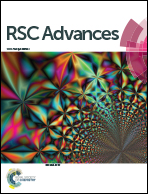Computational and experimental studies on the effect of hydrogenation of Ni-doped TiO2 anatase nanoparticles for the application of water splitting†
Abstract
We have studied theoretically and experimentally the effect of Ni-doping in TiO2 nanoparticles (NPs) on hydrogenation. The doped NPs can be hydrogenated readily in a much shorter time at T < 623 K under near atmospheric H2 pressure. The hydrogenated black NP films exhibit a broad UV-Vis absorption extending well beyond 800 nm. The experimental data can be corroborated by quantum calculations. The barriers for dissociative adsorption of H2 at the Ni and O2c sites on the 2Ni-doped TiO2 surface are significantly reduced from 48 kcal mol−1 on the undoped surface to 17 and 12 kcal mol−1, respectively. The computed densities of states of the doped TiO2 also show new absorption peaks in the band-gaps of the hydrogenated systems which exhibit a high efficiency of solar water-splitting over those of non-hydrogenated samples based on our preliminary study. The theoretical result also indicates that Ni-doping significantly affects the enthalpies of hydrogenation for formation of 2HO(b) and H2O(b) in the bulk from 7 and 19 kcal mol−1 in the undoped TiO2 to −76 and −69 kcal mol−1 in the 2Ni–TiO2 system, respectively, with a > 80 kcal mol−1 increase in exothermicities.


 Please wait while we load your content...
Please wait while we load your content...